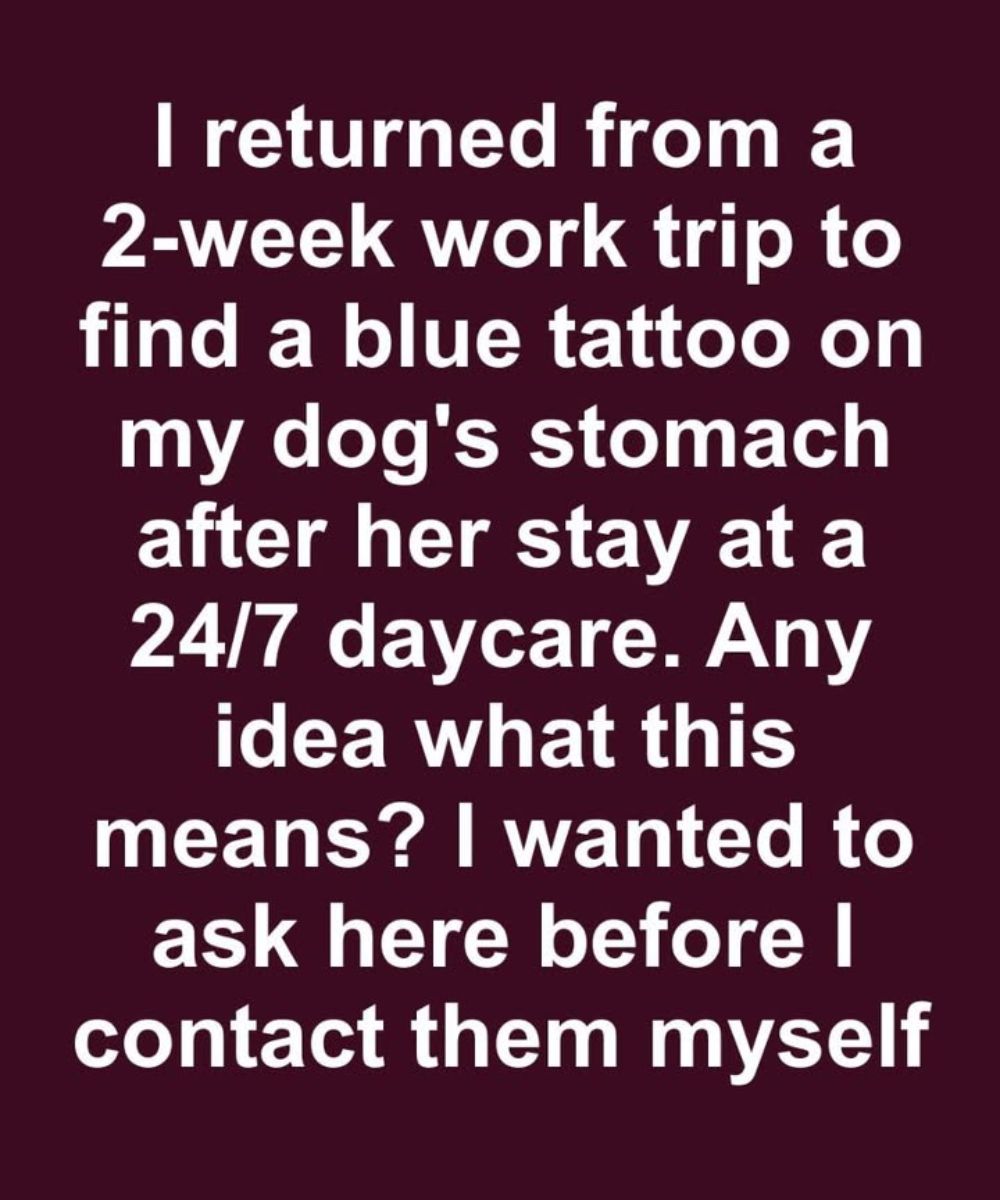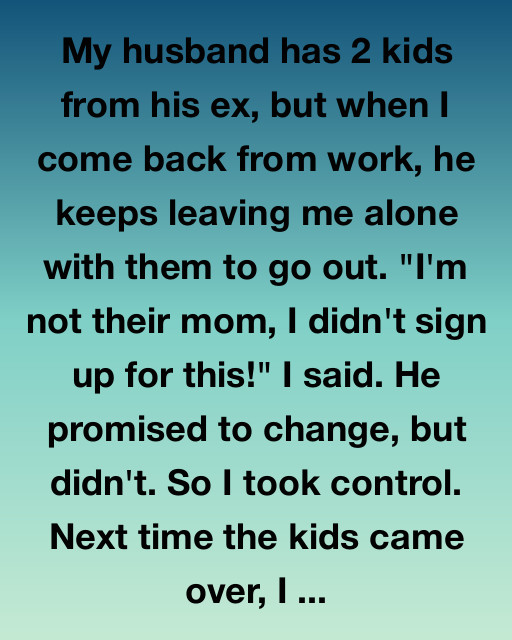I returned from a 2-week work trip to find a blue tattoo on my dog’s stomach after her stay at a 24/7 daycare.
Any idea what this means? I wanted to ask here before I contact them myself.
That’s what I typed into the neighborhood Facebook group on a random Tuesday afternoon, still jetlagged and mildly disoriented. I was standing in my kitchen, sipping lukewarm coffee and staring at the tiny blue mark on Zola’s belly. It looked like a small, faded letter or symbol, about the size of a grain of rice.
I’d only noticed it while giving her a bath that morning. Zola, my four-year-old rescue mutt, was usually terrified of water, so getting her wet took both patience and a handful of peanut butter. But as I lathered her, there it was—like a stamp from somewhere she’d never been before.
The responses poured in fast. Most of them were guesses. “Could be a spay tattoo,” someone wrote. “They do that after surgery sometimes to show the dog’s been fixed.” Another person said it could be a microchip indicator, but I already knew she had a chip—and that didn’t require any tattoos.
Then a woman named Lucinda chimed in. “Some shelters or clinics mark dogs that have been part of a breeding or spay/neuter program. Check her medical records. You sure the daycare didn’t take her to a vet while you were gone?”
That caught me off guard.
I hadn’t thought about that. I’d left Zola at a place called “Paws & Peace”—a 24/7 boarding and daycare center in the suburbs that had glowing reviews, indoor/outdoor play areas, and a staff that posted daily photo updates. They seemed responsible. But still, I never signed off on any medical procedures.
I pulled out the packet they’d given me at pickup. A lot of it was standard—feeding schedules, nap times, notes about her behavior (“sweet but shy, loved ball time”). But on the very last page, tucked under a coupon for a free grooming session, was a form I hadn’t noticed.
“Zola participated in our complimentary wellness check with visiting vet Dr. Mina Reyes on July 2nd.”
My stomach dropped.
Complimentary? No one had told me anything about that. And it wasn’t even part of the original paperwork I signed before my trip.
I called them.
The receptionist, a young guy named Taren, answered. “Hi! This is Paws & Peace. How can I help?”
I explained the situation. Mentioned the tattoo. Asked—gently—if they had taken Zola to a vet.
There was a pause.
“Ohhh,” he said slowly. “Yeah, I think I remember that week. Dr. Reyes came by for our monthly wellness program. We offered free spay/neuter verifications and microchip scans for the dogs staying with us. Zola had a check-up, but no treatments or shots. Just a visual exam. The tattoo… might be a standard spay mark. Some vets do that if there’s no medical record confirming the dog’s fixed.”
“But she already is fixed,” I said.
“I see that now in your intake form. Huh… that’s odd. Let me check with Dr. Reyes and get back to you.”
He promised a call back within 24 hours.
That night, I sat with Zola on the couch, absentmindedly rubbing behind her ears while my mind spiraled. I knew she couldn’t tell me what happened—but she’d been quieter than usual since we got back. Maybe I was imagining it, but it felt like something had shifted.
The next afternoon, the call came—not from Taren, but from Dr. Reyes herself.
“Hi, this is Dr. Mina Reyes. I was told you had some concerns about a mark found on your dog?”
Her voice was calm, measured. I explained everything again, slower this time.
She paused. “Ah. Yes. I do remember Zola. Sweet temperament. It’s my policy to tattoo a small blue line on the abdomen of any female dog who doesn’t have verified spay documentation. It helps prevent unnecessary surgery in the future.”
“But she already had surgery,” I repeated.
“I wasn’t informed of that, unfortunately. The staff gave me a list of dogs without up-to-date spay records. Zola was on that list. So, I marked her accordingly.”
It was all very clinical. Matter of fact. But I was fuming.
“No one contacted me. You tattooed my dog without permission.”
“I understand that you’re upset, but the tattoo is non-invasive, done under mild sedation, and is a recognized veterinary standard.”
It was like she didn’t hear me. Zola wasn’t just some number on a clipboard—she was my dog.
After I hung up, I sat at the dining table with the same sinking feeling I’d had once in college, when I found out my roommate had gone through my things while I was away. It wasn’t about what she found—it was the invasion.
I needed to do something.
I wrote an email to the daycare. Firm, respectful, but clear. I attached photos of Zola’s belly, screenshots of our original agreement, and a detailed account of my conversation with Dr. Reyes. I asked for an explanation, and for accountability.
A few days passed. Then I got an email from the owner—someone named Adil Kesari.
His tone was different. Apologetic. Empathetic.
He wrote, “First of all, I want to sincerely apologize for what happened. You trusted us with your dog, and we failed to communicate a significant action taken during her stay. That’s on us.”
He explained that Dr. Reyes had been working with them for over a year, offering free wellness services as part of an optional program. But there had been a miscommunication—new staff had assumed the procedure was covered under standard consent. It wasn’t.
“We’re reworking our entire intake and vet consent process starting this week,” he added. “And I’d like to offer you a full refund for Zola’s stay, as well as a lifetime membership for grooming or daycare services—no expiration.”
That surprised me. It felt… sincere.
I sat with that for a bit.
Then something even more unexpected happened.
Two weeks later, I received an envelope in the mail. It was hand-addressed. Inside was a note from Dr. Reyes.
It read:
“I owe you a personal apology. After reviewing everything, I see now that I acted on incomplete information. I never should’ve made an assumption, and I regret that my actions caused you distress. Veterinary medicine isn’t just about procedures—it’s about trust. I’m truly sorry.”
There was also a small voucher for a free vet wellness check, with no expiration.
I stared at the note for a long time. It didn’t erase the frustration, but it helped.
And slowly, I started letting go of the anger.
Zola bounced back too. Whatever quiet spell she’d been under lifted. Within a month, she was chasing squirrels and demanding belly rubs like her usual self. That little tattoo was still there—but I stopped seeing it as a violation.
I started seeing it as a reminder.
A reminder that even when mistakes happen, how people respond matters more than the mistake itself.
It would’ve been easy for the daycare to brush me off. Or for the vet to defend her decision without reflection. But they didn’t. They owned it. They grew from it. And honestly, so did I.
We all mess up sometimes. But grace—offered and received—goes a long way.
Zola didn’t know what had happened, but she taught me more about forgiveness than anyone else could have.
So yeah, maybe it started with a tiny blue tattoo on her stomach.
But it ended with something bigger: a renewed belief that kindness and accountability still exist, even when it doesn’t feel like it at first.
And if you ever find something unexpected or unsettling—ask questions, speak up, and lead with honesty. You might be surprised by what comes back.
Thanks for reading. If this story moved you, share it with someone who loves their pets like family. Let’s remind folks how much goodness still lives in the little moments. ❤️🐾
👇 Share this story if you believe in second chances.




